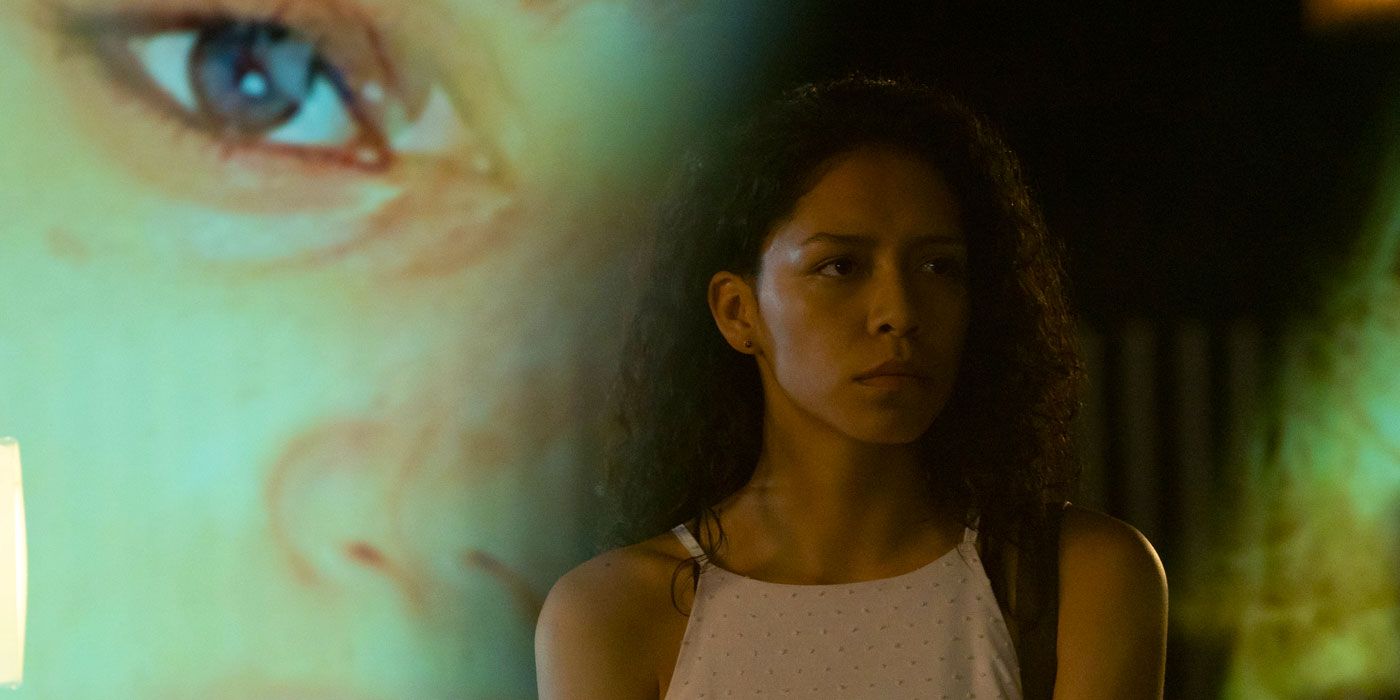Hiding somewhere in Netflix’s slow, meandering horror series Chambers (premiering April 26) is a decent 90-minute movie about the terror of having your identity subsumed by someone from beyond the grave, the kind of thing that Blumhouse could make work on a small budget with an inventive up-and-coming filmmaker. Instead, Chambers is a 10-episode slog through its basic plot points, dragged out with extraneous side characters and subplots and filled with stock portentous imagery promising horrifying developments that are always just around the corner.
Although recognizable stars Uma Thurman (who’s also a producer) and Tony Goldwyn show up in substantial supporting roles, the main cast is made up of relatively unknown young actors playing teenagers, in the kind of setting that seems tailor-made for a CW or Freeform drama. The working-class town of Cottonwood, Arizona, is just down the road from the ultra-wealthy enclave of Crystal Valley, a Sedona-like haven for spiritually minded tourists, as well as from the local Navajo reservation, and members of all three communities coexist somewhat uneasily. Seventeen-year-old Sasha Yazzie (Sivan Alyra Rose) finds herself caught in the crossfire of those communities when she suffers a freak heart attack and receives a heart transplant from fellow teenager Becky Lefevre (Lilliya Scarlett Reid), who died under mysterious circumstances.
Sasha comes from a Navajo family, but lives in Cottonwood with her uncle and legal guardian Frank (Marcus LaVoi), and Becky comes from across the tracks in Crystal Valley. Soon, Becky’s affluent parents Ben (Goldwyn) and Nancy (Thurman) start to take a keen interest in Sasha’s life, offering her a scholarship to attend the upscale private high school where Becky was enrolled. There, she encounters Becky’s twin brother Elliott (Nicholas Galitzine), a recovering drug addict, along with Becky’s friends and frenemies, all of whom seem to have something sinister to hide. What exactly happened the night Becky died? Sasha takes it upon herself to find the answers, no matter what the cost.
She’s motivated by more than curiosity or even a sense of justice; ever since receiving her transplant, Sasha’s been having strange visions and experiences that appear to indicate that Becky’s spirit is somehow inhabiting her body, and they only increase once Sasha starts spending time with Becky’s friends and family. She believes that uncovering the truth about Becky’s death may be the only way to save herself from being taken over by the young woman’s ghost. It’s clear from early in the first episode that Becky is asserting her power over Sasha, but it takes the characters a frustratingly long time to figure out what the audience already knows, and the series' numerous red herrings don’t provide much of a distraction.
There’s a lot of thematic potential in the race and class divide of the setting, and of Sasha’s own life, but creator Leah Rachel and her writing team leave most of it unexplored, or touch on it only superficially, in service of another cheap jump scare or fake-out that spurs Sasha to further reckless action. Sasha and Frank are both somewhat estranged from the Navajo community, and Frank in particular disavows Navajo spiritual practices in favor of modern medicine and scientific data. Sasha’s mixed-race boyfriend, TJ (Griffin Powell-Arcand), is torn between the two sides of his heritage. And the idea of a blonde white girl literally colonizing the body of a Native American teenager is certainly thematically powerful.
The show mostly downplays these ideas, though, and its use of Native American spirituality follows typical horror-movie conventions, as shorthand for Sasha’s disturbed spirit and the darkness inside her. The other main spiritual aspect comes from the New Age-style organization headquartered in Crystal Valley, which has cultish overtones and seems to want Sasha for its own nefarious purposes. Lili Taylor is underused as one of the group’s leaders, whose serene benevolence must hide something darker. The show would have been more focused with her (or someone) as a clear antagonist, rather than just vague premonitions and ominous glances.
The young actors aren’t quite up to selling that ambiguity, and the determined Sasha more often comes across as petulant and whiny rather than brave or disturbed. The adults mostly get stuck in useless subplots, from Frank’s dealings with petty criminals to Nancy’s (possibly self-induced) health issues, and their storylines get conveniently dropped whenever they aren’t needed to fill out an episode. Since nearly everyone’s motivations need to remain opaque for them to be viable suspects, there isn’t a lot of character development for anyone except Sasha, and she’s busy being obscured by another character. The only person on the show who seems to make any sensible decisions is Sasha’s best friend Yvonne (Kyanna Simone Simpson), and even she gets drawn into supernatural nonsense as the season goes on, ascribing mystical origins to her mother’s worsening mental illness.
Whatever did or didn’t happen on the night Becky died, the show drains all excitement from discovering the answers as it plods toward the end of the season. Aside from a couple of jarring instances of nudity and a handful of swear words, Chambers could easily fit on The CW or Freeform, where it would probably have livelier pacing and more fully realized supporting characters, with an eye on long-term storytelling. Instead, the thin story gets stretched even thinner, and the occasional creepy moments aren’t nearly enough to sustain it.

